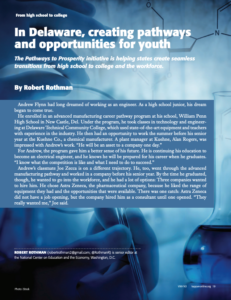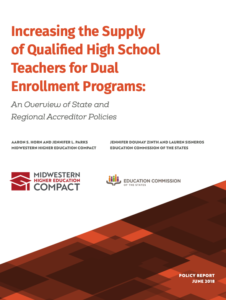Models Around the Nation
Research References
 This resource provides a national comparison of state policies and activities related to secondary career and technical education (CTE). This 50-State Comparison does not include CTE information at the postsecondary level.
This resource provides a national comparison of state policies and activities related to secondary career and technical education (CTE). This 50-State Comparison does not include CTE information at the postsecondary level.
Pechota, D., Kelly, T., & Perez, Z. (2020). 50-State Comparison: Secondary Career and Technical Education. Denver, CO: Education Commission of the States.
Retrieved from https://www.ecs.org/50-state-comparison-secondary-career-and-technical-education/
 The NYC P-TECH Grades 9-14 schools are early college and career high schools that are part of a public education reform movement in the United States and across the globe. They aim to lower many of the barriers that deter students underrepresented in higher education and prepare students for college and career — not one or the other — which is a different approach to contemporary high school reform than many others take. This report presents an overview and evaluation of the the NYC P-TECH Grades 9-14.
The NYC P-TECH Grades 9-14 schools are early college and career high schools that are part of a public education reform movement in the United States and across the globe. They aim to lower many of the barriers that deter students underrepresented in higher education and prepare students for college and career — not one or the other — which is a different approach to contemporary high school reform than many others take. This report presents an overview and evaluation of the the NYC P-TECH Grades 9-14.
MDRC. (2018). An Overview of the Nyc P-Tech Grades 9-14 Model. New York, NY.
Retrieved from https://files.eric.ed.gov/fulltext/ED595264.pdf
The Tennessee Board of Regents System (TBR), and its community colleges are positioned to improve retention rates by giving greater attention to their dual enrollment students. This brief study of one cohort of students at Walters State Community College (WSCC), located in East Tennessee, noted a major disparity in retention between students with dual enrollment experience and those without, suggesting an extant need to give particular consideration to institutional approaches designed to reinforce the dual enrollment programs and the students’ experience in said programs. Doing so may not only address the initiative of providing high quality dual enrollment classes to high school students but also improve institutional retention rates.
Hunter, M. P., & Wilson, J. E. (2019). Dual Enrollment and Retention in Tennessee Community Colleges: Implications for Practice. Community College Journal of Research and Practice, 4(3), 232–236.
Retrieved from https://www.tandfonline.com/doi/full/10.1080/10668926.2018.1428240?scroll=top&needAccess=true
 Inspired by youth development systems that have long been in place in other high-performing nations, the Pathways to Prosperity initiative is helping states create seamless transitions from high school to college and the workforce. This model calls upon educators, business leaders, and government officials to work together to design opportunities for young people to explore potential careers, complete paid internships in growing fields, get an early start on relevant college coursework, and earn industry-recognized credentials.
Inspired by youth development systems that have long been in place in other high-performing nations, the Pathways to Prosperity initiative is helping states create seamless transitions from high school to college and the workforce. This model calls upon educators, business leaders, and government officials to work together to design opportunities for young people to explore potential careers, complete paid internships in growing fields, get an early start on relevant college coursework, and earn industry-recognized credentials.
Rothman, R. (2017). In Delaware, Creating Pathways and Opportunities for Youth. Phi Delta Kappan, 99(November ), 19–24.
Retrieved from https://journals.sagepub.com/doi/10.1177/0031721717739588
 This report seeks to inform state policy for increasing the supply of high school instructors who are qualified to teach in dual enrollment programs.
This report seeks to inform state policy for increasing the supply of high school instructors who are qualified to teach in dual enrollment programs.
Horn, A. S., Parks, J. L., Zinth, J. D., & Sisneros, L. (2018). Increasing the Supply of Qualified High School Teachers for Dual Enrollment Programs: An Overview of State and Regional Accreditor Policies. Minneapolis, MN: Midwestern Higher Education Compact.
Retrieved from https://files.eric.ed.gov/fulltext/ED585087.pdf
Other Research Resources
- Edmunds, J. A. (2016). Early College for All: Efforts to Scale up Early Colleges in Multiple Settings. Evanston, IL: Society for Research on Educational Effectiveness. Retrieved from https://files.eric.ed.gov/fulltext/ED566988.pdf
- Anderson, K., & Mire, M. E. (2016, May). Professional Learning: Trends in State Efforts. Benchmarking State Implementation of College- and Career-Readiness Standards. Retrieved from https://www.sreb.org/benchmarking-readiness-standards
- Voytek, S.(2016). Legislative Summary & Analysis. Advance CTE. Retrieved from https://ns4ed.s3.us-east-2.amazonaws.com/matn/1hr5587_summary.pdf
- Karp, M. (2013). Dual Enrollment for College Completion. Community College Research Center. Retrieved from https://ns4ed.s3.us-east-2.amazonaws.com/matn/2tn-de-final-policy-recommendations-1-24-13_full-version.pdf
- Accountability Steering Committee. (2016, June). Kentucky Department of Education. Retrieved from https://ns4ed.s3.us-east-2.amazonaws.com/matn/36-2-16-acct.-steering-commitee-fnal.pdf